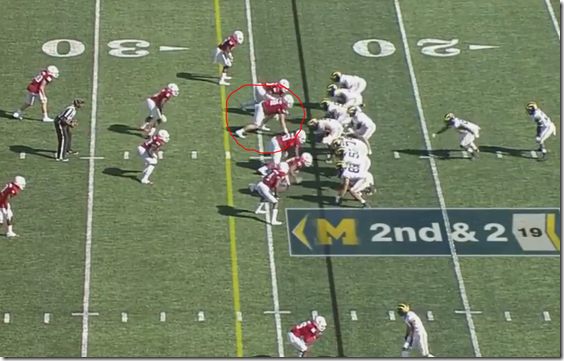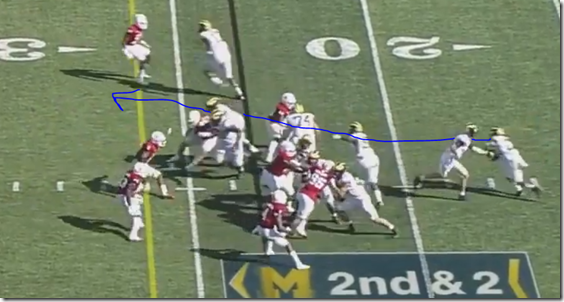Neck Sharpies: The Fullback Counter Trap

I used to be really good at slaps, that game where your opponent puts their hands over yours and you try to whack them before they can pull away. My best trick was I’d make my elbow twitch on one side then *WHAP* the other side. I’d get so many in a row with this that my siblings stopped wanting to play.
Tom Allen probably doesn’t want to play slaps with Harbaugh anymore.
This was a beautiful play. I thought so. Brian thought so. Jon Duerr thought so. James Light thought so. Harbaugh apparently liked it enough to call it three times in a five-play drive. We all guessed Michigan would have preferred not to put it on tape before the Penn State game but since it is let’s dive into it.
THE PLAY:
It’s early in the 4th quarter. Michigan is up just 13-10 over Indiana and gets the ball back on their 16 yard line after Indiana punts on 4th and 1. The first play is a split zone off the same look with which they’d successfully run a TE motion crack sweep, and it goes for 8 yards when Onwenu and Bredeson beat their respective DTs (Bredeson’s guy got up crying for a hold that was probably legit and is never called).
Then out comes this:
It’s a trap play, which itself isn’t very weird. On a trap the backside guard (Bredeson, #74) pulls and the frontside starts blocking down just like on a power play. But instead of having the DE kicked out by a tackle or tight end, they leave the edge guy for a moment and the puller then plows into him. The erstwhile kicker meanwhile is heading downfield hunting linebackers and safeties. The running back then charges through the hole, with a lead blocking fullback if that’s your style.
In this instance Hill didn’t even bother to block Tegray Scales, the WLB, because he’s stumbling over his buddy—Scales managed to right himself and make the tackle, else Higdon is following Hill into the secondary. That’s on Hill for going for a big gain and given the situation (2nd and 2) I’m fine with taking a shot when the worst result is still a first down. Anyway that’s not the interesting part.
The interesting parts are the path that Hill took, and the way they blocked the playside tackle. There are a lot of arrows in a tight space so let me show you who’s blocking whom with colors:
Let’s examine the two really cool wrinkles in detail.
[After THE JUMP]
1. Fullback split motion
This was the thing James Light pointed out.
Initial FB path opposite of the play side (split flow) distorted the run fit of the LB at the second level https://t.co/b3oGatcj1e
— James Light (@JamesALight) October 14, 2017
Watch what happens to those linebackers when they see Khalid Hill going to the backside like it’s a dive or split zone.
They see the fullback go that direction and react. It’s several steps the wrong way before they realize their mistake.
2. The Combo That Wasn’t
The most important guy to move on on any inside run is the playside tackle. Traps and pulls work so well because you can block down on this guy. Zones work so well because you can double him off the snap then combo to the next level, with the running back going wherever that guy failed to close. This works because the DT is reacting to zone and THEN gets blocked down like a chump.
He starts in a 3-tech position, where he’s in the right spot to defend the B gap off Onwenu’s shoulder.
At the snap Onwenu hits him back a bit as Bushell-Beatty is exploring a move around him. This feels like a zone scoop: if Onwenu gets past him and JBB gets around him that’s trouble for a DT. So he starts giving up ground to work back across JBB. If this is zone and Onwenu releases when JBB is still not around this DT still has his gap.
Only JBB isn’t stepping around. He’s blocking down. DT just made that job super-easy: the right tackle needs only to seal to keep that “C” gap wide. Meanwhile Bredeson’s “pull” is really a kickout of the DE, who didn’t get to the hashes and set up low like the MSU dude did last week.
Anyway this really messes with a DT expecting a zone run. Here he’s battling to avoid getting scooped, and his battle to do so ends up putting him exactly where he’d be if JBB just demolished him with a downblock. If Michigan didn’t have their zone tendency established, that guy’s expecting a blockdown, so it’s a good example of how being a power and zone team opens up some neat tricks.
--------------------------
Run it again, Sam!
Yeah, so after an unsuccessful ISO run where the linebackers are still reacting immediately to whatever the fullback does, Michigan goes back to the trap play, this time to the strongside (still the right side) with Poggi and Evans. Indiana has now gone to a 5-3 look—doesn’t matter it works again!
It helped that Indiana was slanting away from it, but watch those LBs all still take false steps when the fullback goes to to the backside, giving everybody angles to make their blocks.
If the safeties hadn’t been playing at 7 and 9 yards (virtually in the box) this one could have broken huge.
--------------------------
Third time’s the charm!
Michigan lines up again right away and Indiana calls timeout. When they come back, in what must have been an homage to Mr. DeBord, the Wolverines run the exact same play to the exact same side. Again Indiana slants away from it:
This time the MLB (Carpenter) didn’t get as suckered by the fullback fakeout, but not so Scales, who then tries to make up for it by leaping back. That puts him a little off-balance when Poggi comes through the hole and finally it works like it’s drawn up, with Poggi sealing Scales outside. Higdon splits both safeties who’d come down too far, and it’s all over but the snowglobe (or whatever wacky M-IU finish the furies have in store this year).
November 7th, 2017 at 4:04 AM ^
One school of thought says to key the guards. An other says to read the backs- be that near back, far back, etc. Another says to read the "triangle" from the guards to FB in the I. Or a combination- reading the backs "through" the near guard.
Reading the backs is probably easier tp teach/learn, but generally guards give a truer read, especially if they pull and cross the center.
October 18th, 2017 at 3:20 PM ^
October 18th, 2017 at 3:44 PM ^
Now THIS is what we thought we would get with the Harbaugh-fense! More please.
October 18th, 2017 at 4:21 PM ^
Because that is all I can give.
October 18th, 2017 at 4:55 PM ^
October 18th, 2017 at 8:02 PM ^
October 18th, 2017 at 8:15 PM ^
November 7th, 2017 at 4:02 AM ^
It depends on who they are pulling for. If they are pulling for the DT (FB trap) or the End (Counter), the are turning and running to blow him out of the hole. If they are pulling for the LB (such as in Power), they will pull or "skip pull" and stay more square, so they can get the LB and not overrun the play.
October 18th, 2017 at 10:20 PM ^
October 19th, 2017 at 12:07 AM ^





Comments